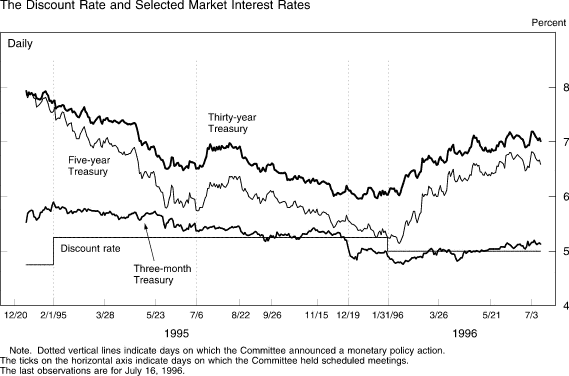Monetary Policy, Financial Markets, and the Economy over
the First Half of 1996
Information available around the turn of the year suggested that
the economy had downshifted after posting a strong gain in the third
quarter of 1995. The growth of final demand appeared to have
slowed, reflecting importantly a deceleration of consumer
spending. In addition, hesitant growth abroad and a strengthening in
the foreign exchange value of the dollar relative to the levels
prevailing at mid-1995 were seen as limiting the prospects for further
growth in exports. The slowdown in the growth of final demand had given
rise to inventory buildups in some industries; in turn, the
production cutbacks undertaken in response to those buildups were
having a further damping effect on economic activity. Meanwhile, data
on prices and wages suggested that inflation performance
continued to be fairly satisfactory--indeed, better than many members
of the FOMC had expected as of midyear 1995. To keep the stance
of monetary policy from becoming effectively more restrictive owing to
the slowdown in inflation in the second half of last year, and to
promote sustainable growth, the Committee eased the stance of policy in
December 1995 and again at the end of January 1996, bringing the
federal funds rate down a half percentage point in total, to
5-1/4 percent.
Most participants in financial markets were unsurprised by
these policy adjustments, given the economic backdrop. Moreover, they
anticipated that there would be scope for additional easing steps in
the coming months. Thus, between mid-December and the end of January,
interest rates on Treasury securities generally moved lower, especially
at short and intermediate maturities, and stock price indexes edged
higher on balance. The dollar strengthened slightly on net against the
currencies of the other (Group of Ten) G-10 countries, reflecting in part
disappointing news about the pace of activity in Europe and
consequently larger declines in interest rates there than in the United
States.
The underlying trends in the economy early in the year
were obscured to a degree by extraordinarily adverse weather that
affected a significant part of the country. Through the course of the
next few months, however, it became increasingly clear that the economy
had regained vitality. Consumer spending perked up after
a lackluster holiday season and was only temporarily depressed by the
severe winter. Business demand for equipment proved quite strong, as
did housing demand. The strengthening in sales facilitated businesses'
efforts to control their inventories, and as that situation improved,
industrial production rebounded smartly. Overall employment growth was
brisk, and by June the unemployment rate reached its lowest level in
six years.

Inflation during the first half of the year was generally well
behaved. Energy prices surged, mainly in response to a run-up in the
world price of oil, and bad news about grain crops raised the prospect
of higher food prices down the road. However, price inflation for
consumer items other than food and energy held steady or moved a bit
lower. Labor costs presented a mixed picture. The increase in total
hourly compensation over the first three months of the year, as
measured by the employment cost index (ECI), was in line with its recent
moderate trend. However, within total compensation, the wage and salary
component of the ECI surged in the first quarter, and further signals
of wage acceleration came from a more rapid increase in average hourly
earnings in the second quarter.
Against the backdrop of stronger activity but subdued inflation
trends, the Federal Reserve made no adjustments to its policy stance
after January. With economic activity more clearly on the upswing,
however, and prospects for a breakthrough on the federal budget seeming
to fade, intermediate- and long-term interest rates reversed course in
February and trended up over subsequent months. Since the end of
December, the yield on the 30-year Treasury bond has increased about
1 percentage point, on net, while the yield on the 5-year note
has risen about 1-1/4 percentage points over the same
period. The rate on three-month bills has edged up only
slightly. Despite the backup in bond yields, major stock-price indexes
rose considerably further through the first half of the year; most of
those gains were erased in late June and the first half of July,
however, as company reports raised questions about the pace of earnings
growth. The rise in bond yields has boosted the dollar in foreign
exchange markets; since mid-April, the dollar has generally traded
against an average of the currencies of the other major industrial
countries about 4 percent above its level at the end of
December.
During the first half of the year, credit remained easily
available to most household and business applicants. Interest rate
spreads on private debt over Treasury securities remained narrow. In
response to the recent increase in delinquencies on credit card
accounts, many banks have tightened their standards for approval of new
accounts, but this appears to have only partially reversed a marked
relaxation of such standards earlier this decade, and banks overall
remain aggressive in the pursuit of new borrowers, especially business
clients. The debt of all domestic nonfinancial sectors combined
expanded at about a 4-3/4 percent annual pace, placing this
aggregate near the middle of its monitoring range. M2 and M3 are
currently near the 5 percent and 6 percent upper boundaries of
their respective growth ranges, in line with the FOMC's expectation as
of last February. In contrast to the experience of the early 1990s,
growth in the monetary aggregates relative to nominal gross domestic product
has been
broadly in line with historical relationships, given the structure of
interest rates.
Economic Projections for
1996 and 1997
|

